Life Cycle Environmental Impact Assessment and Applicability of Synthetic Resin Formwork
Abstract
:1. Introduction
1.1. Purpose of the Study
1.2. Cautions for Selecting Formwork Materials
- (1)
- The material must be easy to work with using manpower and tools, and it must not be destroyed or cracked during nailing.
- (2)
- It must be durable enough to withstand the impact of the contact surface in normal conditions, such as fixing steel reinforcement, fixing the formwork itself, and concrete pouring.
- (3)
- It must be light enough for formwork workers to install and transport. It also must be strong enough to withstand the considerable loads and impacts that may occur during concrete pouring.
- (4)
- It must be stable when exposed to direct sunlight, snow, or rain, and it must be able to withstand excessive twisting and to resist swelling.
- (5)
- It must not excessively absorb moisture from the concrete after it has been poured.
1.3. Research Method and Scope
- (1)
- (2)
- A noise test was conducted to compare the intensity of the noise generated during the construction of synthetic resin formwork to that of the Euro form.
- (3)
- The constructability of the synthetic resin formwork constructed on-site was investigated, and its benefits were compared to those of the Euro form.
- (4)
- The environmental impact of synthetic resin formwork during its production life cycle was evaluated.
2. Materials and Methods
2.1. Synthetic Resin Formwork
2.2. Synthetic Resin Formwork Production Process
3. Applicability Evaluation
3.1. Noise Test
3.1.1. Experimental Plan and Method
3.1.2. Noise Measurement Results
3.1.3. Noise Characteristics as a Function of Frequency
3.2. Application of Synthetic Resin Formwork
4. Procedure for Life Cycle Environmental Impact Assessment
4.1. Assessment Purpose and Scope Setting
4.2. Boundary Conditions
4.3. LCI Data Analysis
4.4. CO2 Evaluation Procedure
4.5. Environmental Impact Assessment
5. Life Cycle Environmental Impact Assessment of Synthetic Resin Formwork
5.1. CO2 Emissions of Synthetic Resin Formwork
5.2. Environmental Impact Assessment of Synthetic Resin Formwork
6. Conclusions
- (1)
- In the high-frequency range, there was a significant difference in sound pressure level between the synthetic resin formwork and the Euro form. This demonstrates that the noise fatigue of the Euro form was higher than that of the synthetic resin formwork at high frequencies. If the high sound pressure levels that come from the Euro form are continuously transmitted to residential areas, then they will have adverse physical and mental effects on nearby residents.
- (2)
- When the synthetic resin formwork was constructed in place of the Euro form, there were no compatibility problems. In addition, after the formwork was removed, the concrete surface finish of the synthetic resin formwork was superior to that of the Euro form even though no oil was applied to the synthetic resin formwork.
- (3)
- The synthetic resin formwork generated approximately 34% more CO2 emissions than the Euro form during production. This is because the CO2 emissions of formwork are generally dominated by the materials used, and the production of synthetic resin formwork generated higher CO2 emissions than the Euro form because of the HDPE, a corrosion-resistant material. However, when the number of uses for formwork was considered, the CO2 emissions produced by the synthetic resin formwork were approximately 32% lower than those of the Euro form.
- (4)
- The environmental impact load of the synthetic resin formwork, considering the number of uses, was 6.6 × 10−7 kg-eq/30 uses, which was approximately 21% lower than that of the Euro form (8.4 × 10−7 kg-eq/30 uses). In addition, based on 30 uses, the impacts of synthetic resin formwork on global warming, acidification, eutrophication, human toxicity, and resource depletion were found to be lower than the Euro form by 30, 38, 38, 38, and 25%, respectively.
Author Contributions
Funding
Institutional Review Board Statement
Informed Consent Statement
Data Availability Statement
Conflicts of Interest
References
- Shin, Y.; Kim, T.; Cho, H.; Kang, K.-I. A formwork method selection model based on boosted decision trees in tall building construction. Autom. Constr. 2012, 23, 47–54. [Google Scholar] [CrossRef]
- Hanna, A.S. Concrete Formwork Systems; Marcel Dekker, Inc.: New York, NY, USA, 2005. [Google Scholar]
- Proverbs, D.G.; Holt, G.D.; Olomolaiye, P.O. Factors impacting construction project duration: A comparison between France, Germany and the U.K. Build. Environ. 1999, 34, 197–204. [Google Scholar] [CrossRef]
- Tam, C.M.; Tong, T.K.L.; Lau, T.C.T.; Chan, K.K. Selection of vertical formwork system by probabilistic neural networks models. Constr. Manag. Econ. 2005, 23, 245–254. [Google Scholar] [CrossRef]
- Ling, Y.Y.; Leo, K.C. Reusing timber formwork: Importance of workmen’s efficiency and attitude. Build. Environ. 2000, 35, 135–143. [Google Scholar] [CrossRef]
- Jin, Y.; Jin, H.; Kang, J. Effects of sound types and sound levels on subjective environmental evaluations in different seasons. Build. Environ. 2020, 183, 107215. [Google Scholar] [CrossRef]
- Sun, X.; Wu, H.; Wu, Y. Investigation of the relationships among temperature, illuminance and sound level, typical physiological parameters and human perceptions. Build. Environ. 2020, 183, 107193. [Google Scholar] [CrossRef]
- Krawczyńska-Piechna, A. Comprehensive Approach to Efficient Planning of Formwork Utilization on the Construction Site. Procedia Eng. 2017, 182, 366–372. [Google Scholar] [CrossRef]
- Sonnenschein, J.; Mundaca, L. Decarbonization under green growth strategies? The case of South Korea. J. Clean. Prod. 2015, 123, 180–193. [Google Scholar] [CrossRef]
- The Government of the Republic of Korea. Third National Communication of Republic of Korea under the United Nations Framework Convention on Climate Change (IPCC); The Government of the Republic of Korea: Seoul, Republic of Korea, 2008.
- Zhang, X.; Shen, L.; Zhang, L. Life cycle assessment of the air emissions during building construction process: A case study in Hong Kong. Renew. Sustain. Energy Rev. 2013, 17, 160–169. [Google Scholar] [CrossRef]
- Korea Energy Economic Institute (KEEI). Final Report-Reduction Potential Analysis of National Greenhouse Gases; Korea Energy Economic Institute (KEEI): Ulsan, Republic of Korea, 2009. [Google Scholar]
- Jang, M.; Hong, T.; Ji, C. Hybrid LCA model for assessing the embodied environmental impacts of buildings in South Korea. Environ. Impact Assess. Rev. 2015, 50, 143–155. [Google Scholar] [CrossRef]
- Kim, J.; Cho, M.; Kim, J. Energy use of households in apartment complexes with different service life. Energy Build 2013, 66, 591–598. [Google Scholar] [CrossRef]
- Adalberth, K.; Almgren, A.; Petersen, E.H. Life cycle assessment of four multifamily buildings. Int. J. Low Energy Sustain. Build. 2001, 2, 1–21. [Google Scholar]
- Peuportier, B.L.P. Life cycle assessment applied to the comparative evaluation of single family houses in the French context. Energy Build 2001, 33, 443–450. [Google Scholar] [CrossRef]
- Asif, M.; Muneer, T.; Kelley, R. Life cycle assessment: A case study of a dwelling home in Scotland. Build. Environ. 2007, 42, 1391–1394. [Google Scholar] [CrossRef]
- Kofoworola, O.F.; Gheewala, S.H. Environmental life cycle assessment of a commercial office building in Thailand. Int. J. Life Cycle Assess 2008, 13, 498–511. [Google Scholar] [CrossRef]
- Blengini, G.A.; Carlo, T.D. Energy-saving policies and low-energy residential buildings: An LCA case study to support decision makers. Int. J. Life Cycle Assess 2010, 15, 652–665. [Google Scholar] [CrossRef]
- Ortiz-Rodríguez, O.; Castells, F.; Sonnemann, G. Life cycle assessment of two dwellings: One in Spain. A developed country, and one in Colombia, A country under development. Sci. Total Environ. 2010, 408, 2435–2443. [Google Scholar] [CrossRef]
- Iyer-Raniga, U.; Wong, J.P.C. Evaluation of whole life cycle assessment for heritage buildings in Australia. Build. Environ. 2012, 47, 138–149. [Google Scholar] [CrossRef]
- Richardson, J.G. Formwork Construction and Practice; Viewpoint Publication: London, UK, 1977. [Google Scholar]
- Wilshere, C.J. Formwork; Thomas Telford: London, UK, 1989. [Google Scholar]
- Korea Ministry of Environment. Hankookhyeng Hwangyeong Yeonghyang Pyeonggajisu Bangbeopron [Korea Environmental Impact Assessment Index Methodology]; Korea Ministry of Environment: Sejong City, Republic of Korean, 2003; p. 166.
- ISO 13315-2; Environmental Management for Concrete and Concrete Structures-Part 2: System Boundary and Inventory Data. International Organization for Standardization: Geneva, Switzerland, 2014; p. 23.
- Nam, K.Y.; Kim, S.D.; Choi, S.; Lee, Y.D. A Study on the Performance Evaluation of Synthetic Resin Formwork Material. J. Korea Inst. Build. Constr. 2019, 9, 151–152. [Google Scholar]
- Nam, K.Y.; Kim, S.D.; Lee, J.U. Characteristics of Harmful Gas Emission of Synthetic Resin Formwork. J. Archit. Inst. Korea 2020, 40, 537. [Google Scholar]
- Nam, K.Y.; Lee, H.J.; Yang, K.H.; Mun, J.H. Evaluation on Flexural Behavior and Proposals of Stiffness Model for Synthetic Resin Formworks. J. Archit. Inst. Korea 2020, 36, 153–159. [Google Scholar]
- Yun, J.H.; Ju, D.H.; Park, T.J.; Kim, J.S. A Study on Characteristics of Noise & Vibration of Hydraulic Turbine Dynamo in Dam. Autumn Annu. Conf. Archit. Inst. Korea 2007, 27, 921–924. [Google Scholar]
- Yun, J.H.; Ju, D.H.; Park, J.C.; Kim, J.S. A Study on the Evaluation of Hydraulic Turbine Dynamo in Dam. Autumn Annu. Conf. Archit. Inst. Korea 2007, 27, 917–920. [Google Scholar]
- Kim, D.G.; Kim, J.S. A Comparative Study on Subjective Response in Accordance with Wearing of Soundproof-Protector in Loud Noisy Workshop. Spring Annu. Conf. Archit. Inst. Korea 2010, 6, 329–331. [Google Scholar]
- Kim, T.H.; Ahn, S.J.; Lee, Y.D.; Nam, K.Y. A Study on the Performance Evaluation and Field Application of Synthetic Resin Formwork. J. Korea Inst. Build. Constr. 2018, 18, 577–584. [Google Scholar]
- Gould, J.V. Designing with Plywood-Considerations for Selecting and Using Plywood Correctly for Concrete Forming. In Proceedings of the Second International Conference on Forming Economical Concrete Buildings; Panarese, W.C., Ed.; American Concrete Institute: Detroit, MI, USA, 1986; pp. 39–48. [Google Scholar]
- Chew, L.T. Specifying Timber for Construction: The Malaysia Experience. Presented at the Seminar on the Use of Malaysian Timber in the Construction Industry, Singapore, 1–31 July 1991. [Google Scholar]
- ISO 14040; Environmental Management—Life Cycle Assessment—Principles and Framework. International Standardisation Organisation: Geneva, Switzerland, 2006.
- Hilton, B.; Williamson, A. Using Surrogate LCAs to Drive Early Design Decisions. Available online: http://lcacenter.org/lcaxii/final-presentations/595.pdf (accessed on 28 August 2012).
- KEITI (Korea Environmental Industry & Technology Institute), Korea LCI Database Information Network. Available online: https://www.epd.or.kr/lcidb.do (accessed on 1 December 1998).
- Yang, K.H.; Seo, E.A.; Jung, Y.B. Effect of Ground Granulated Blast-Furnace Slag on Life-Cycle Environmental Impact of Concrete. J. Korea Concr. Inst. 2014, 26, 13–21. [Google Scholar] [CrossRef] [Green Version]
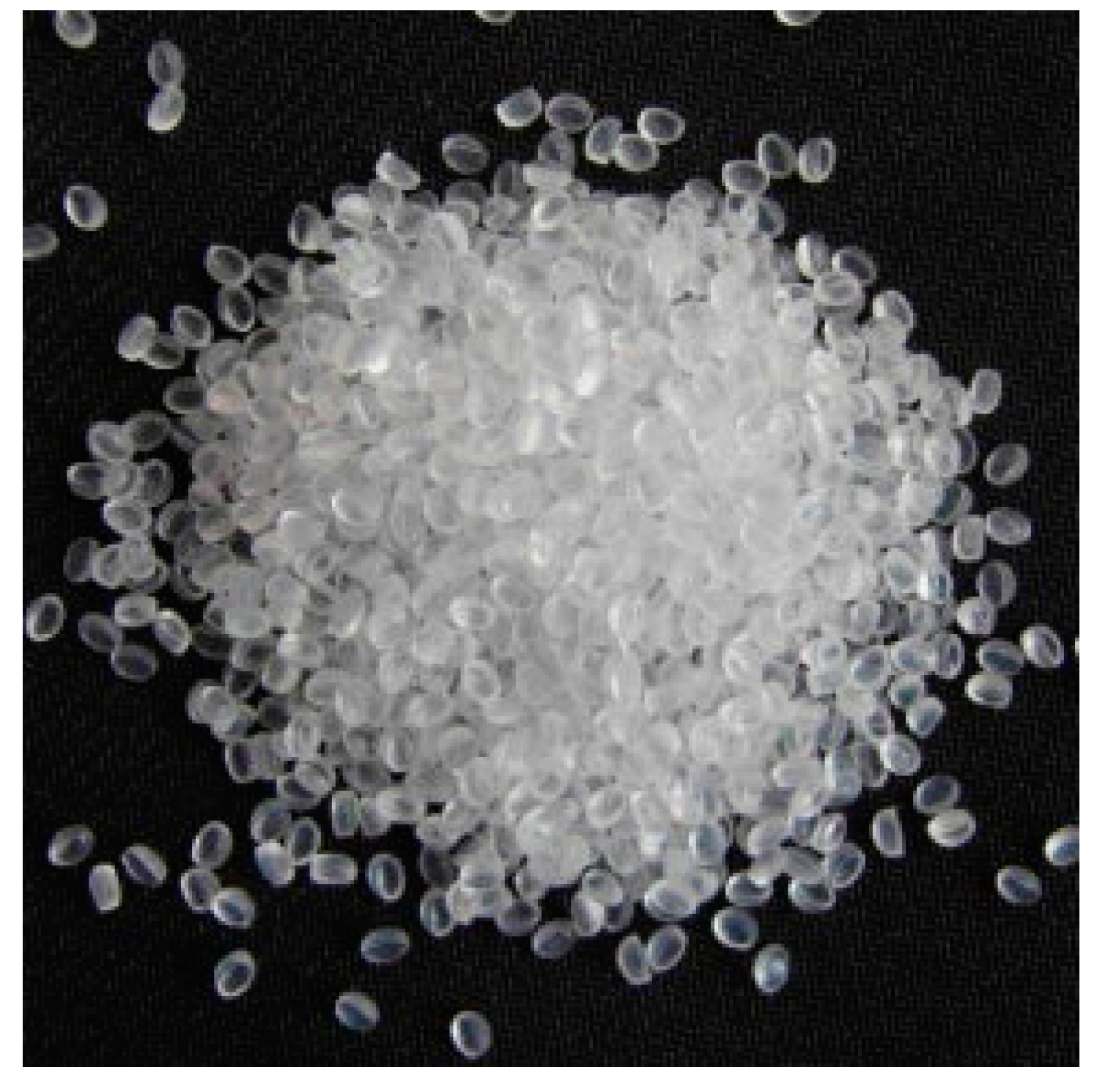

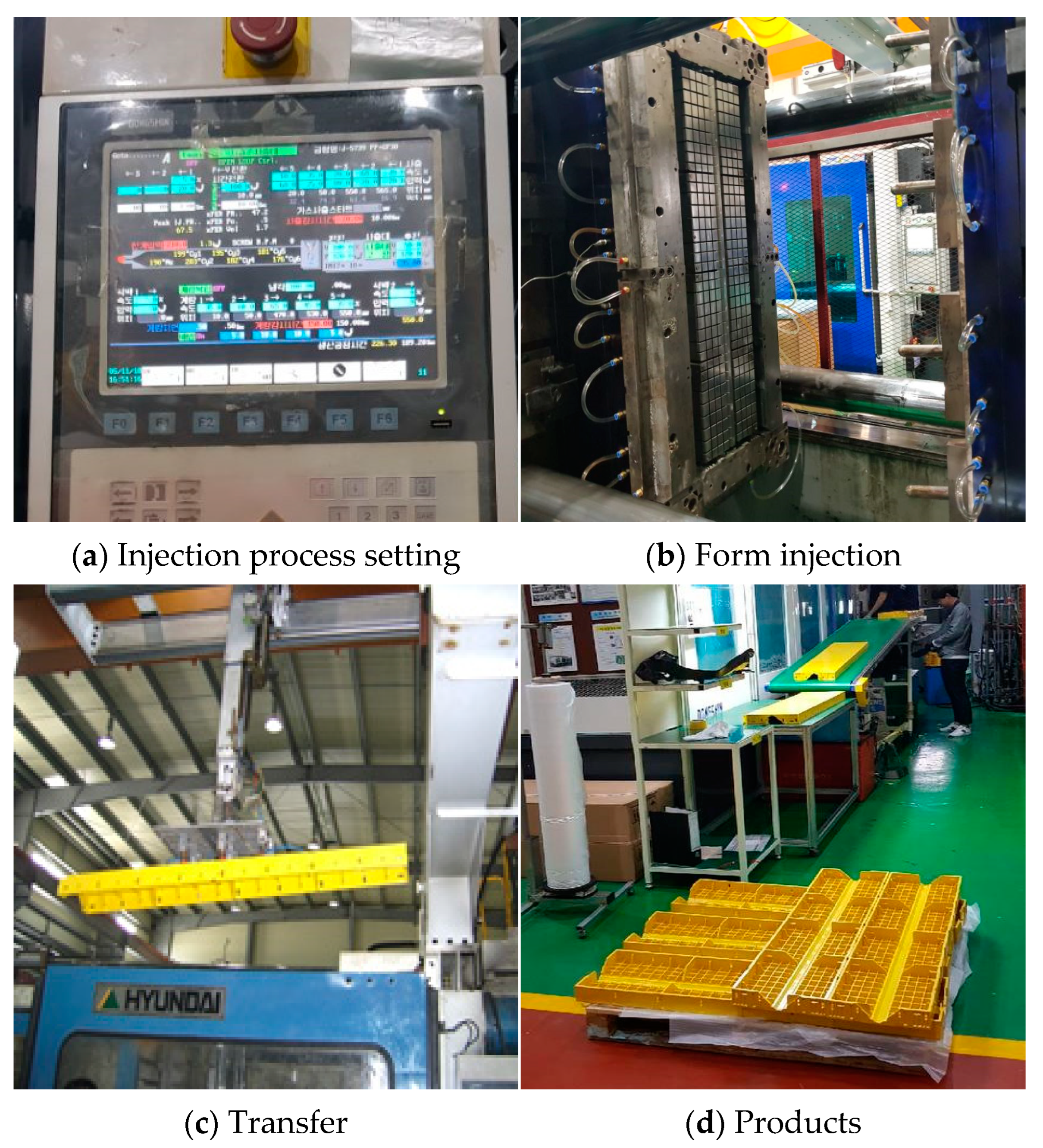
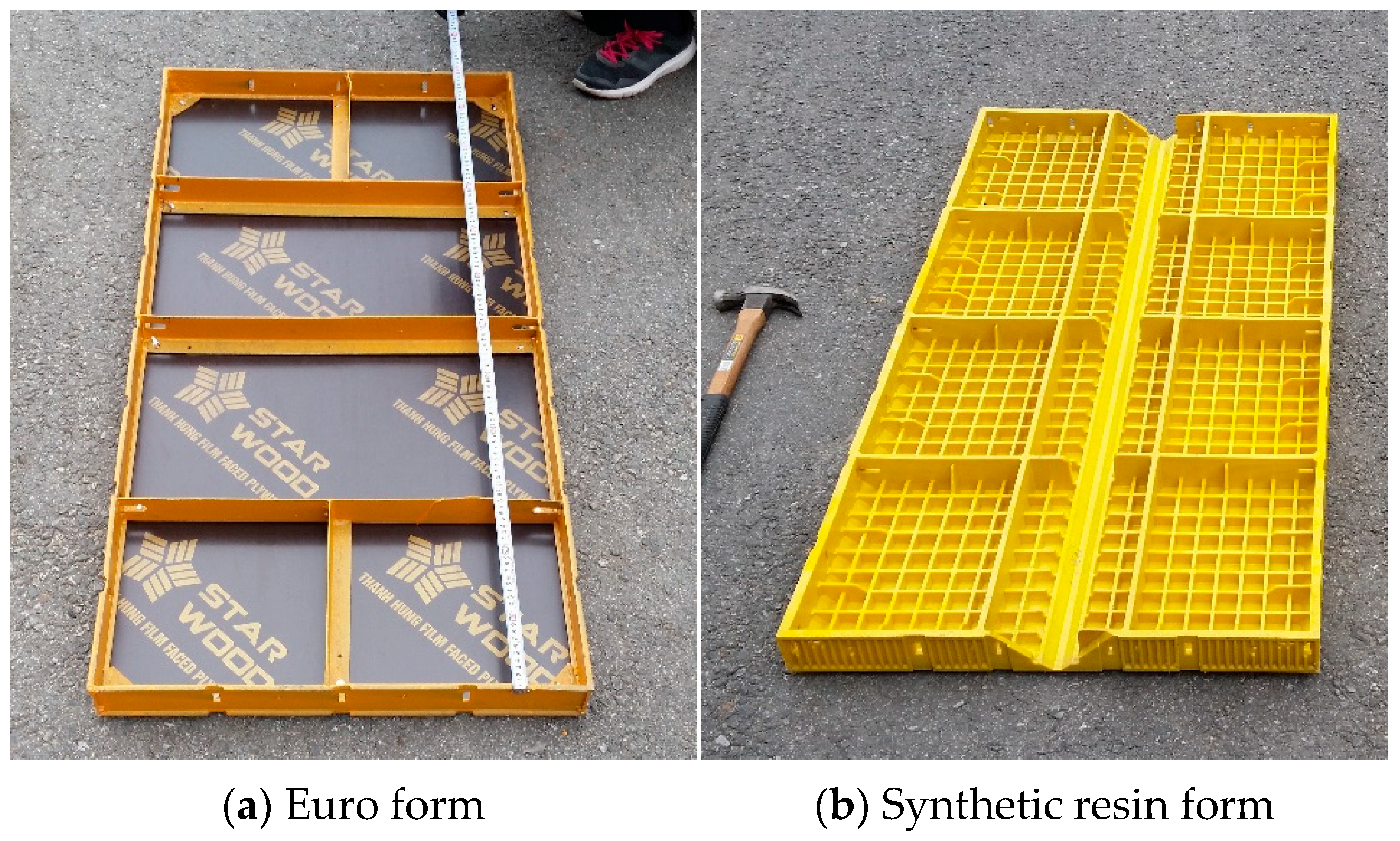
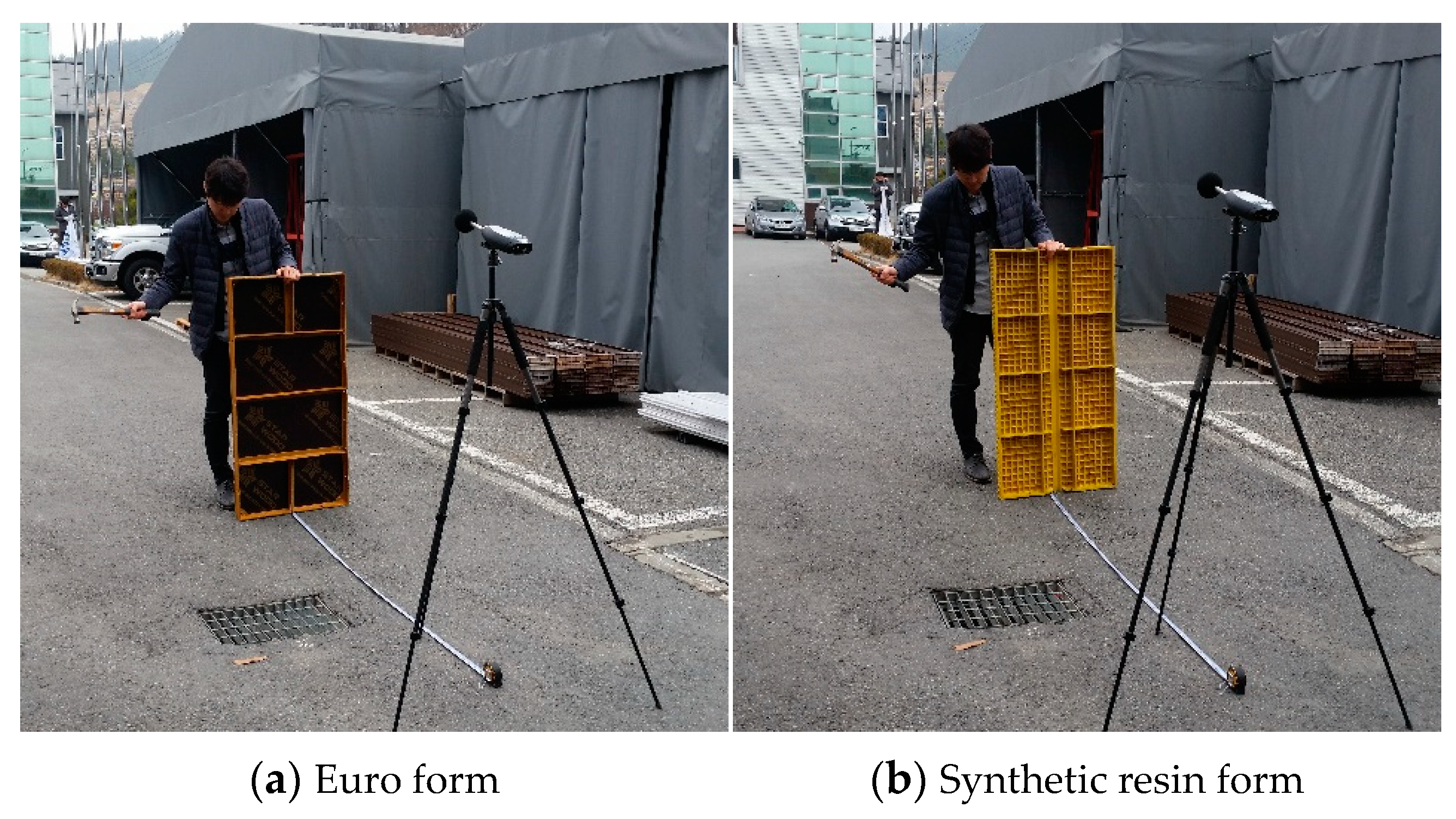
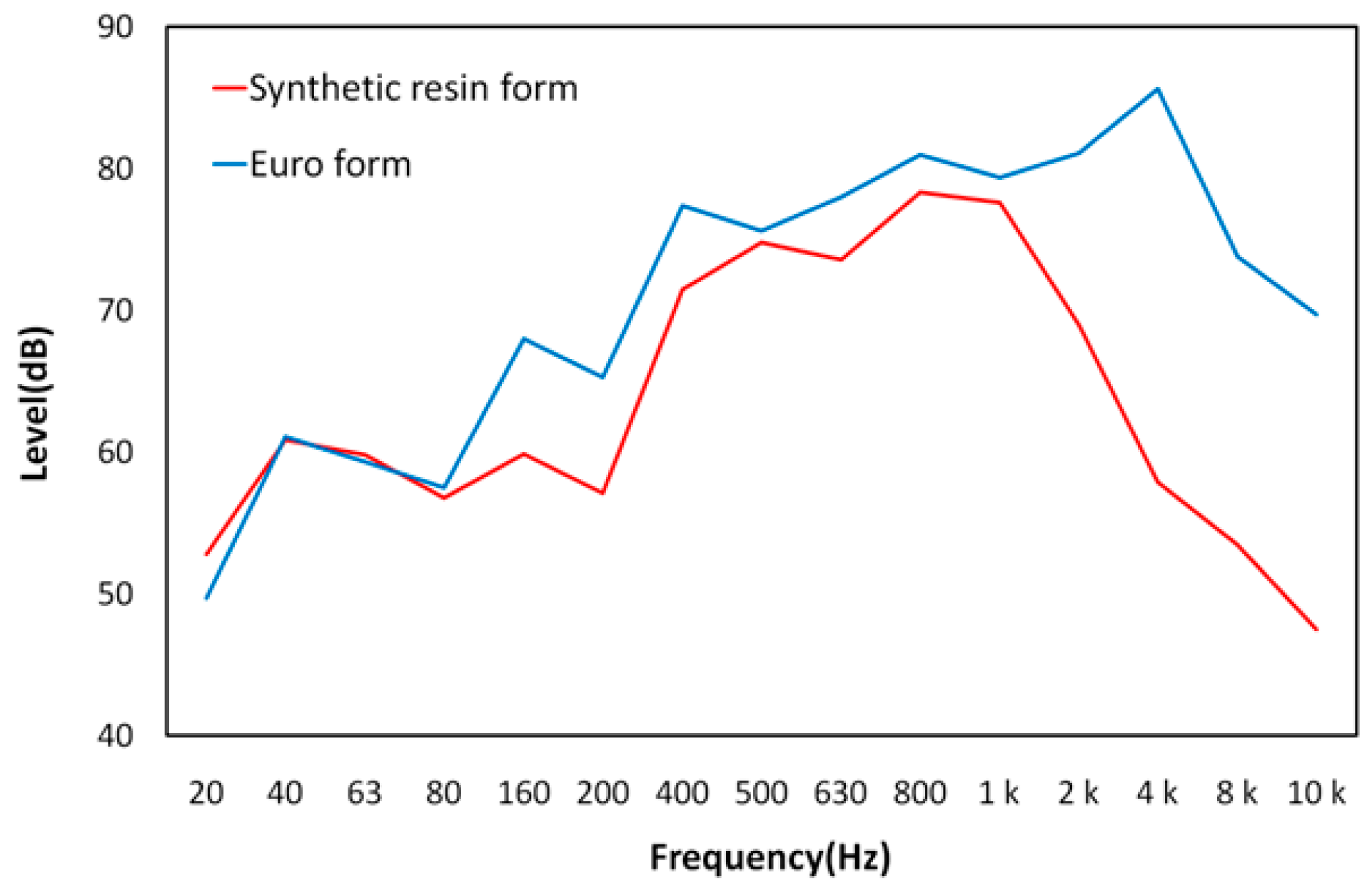
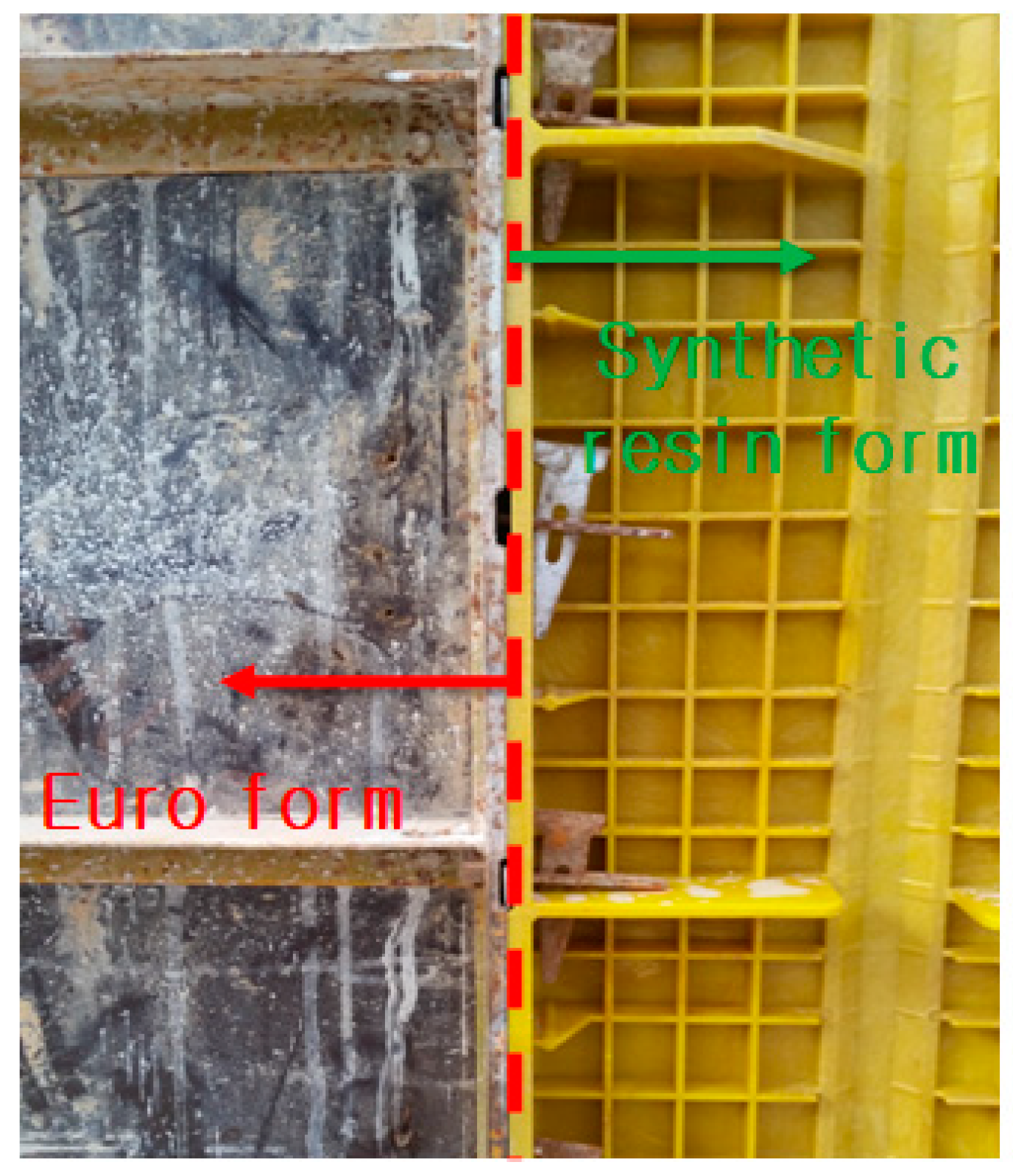


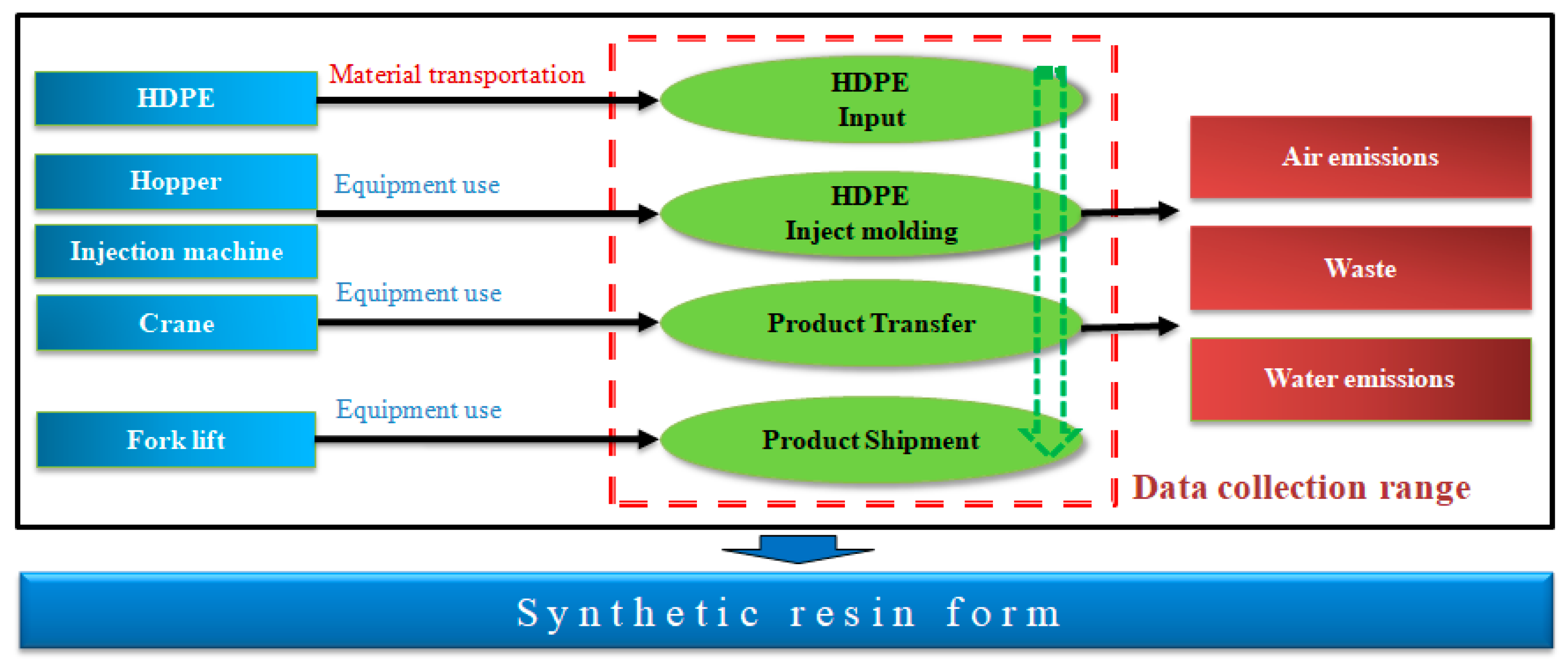


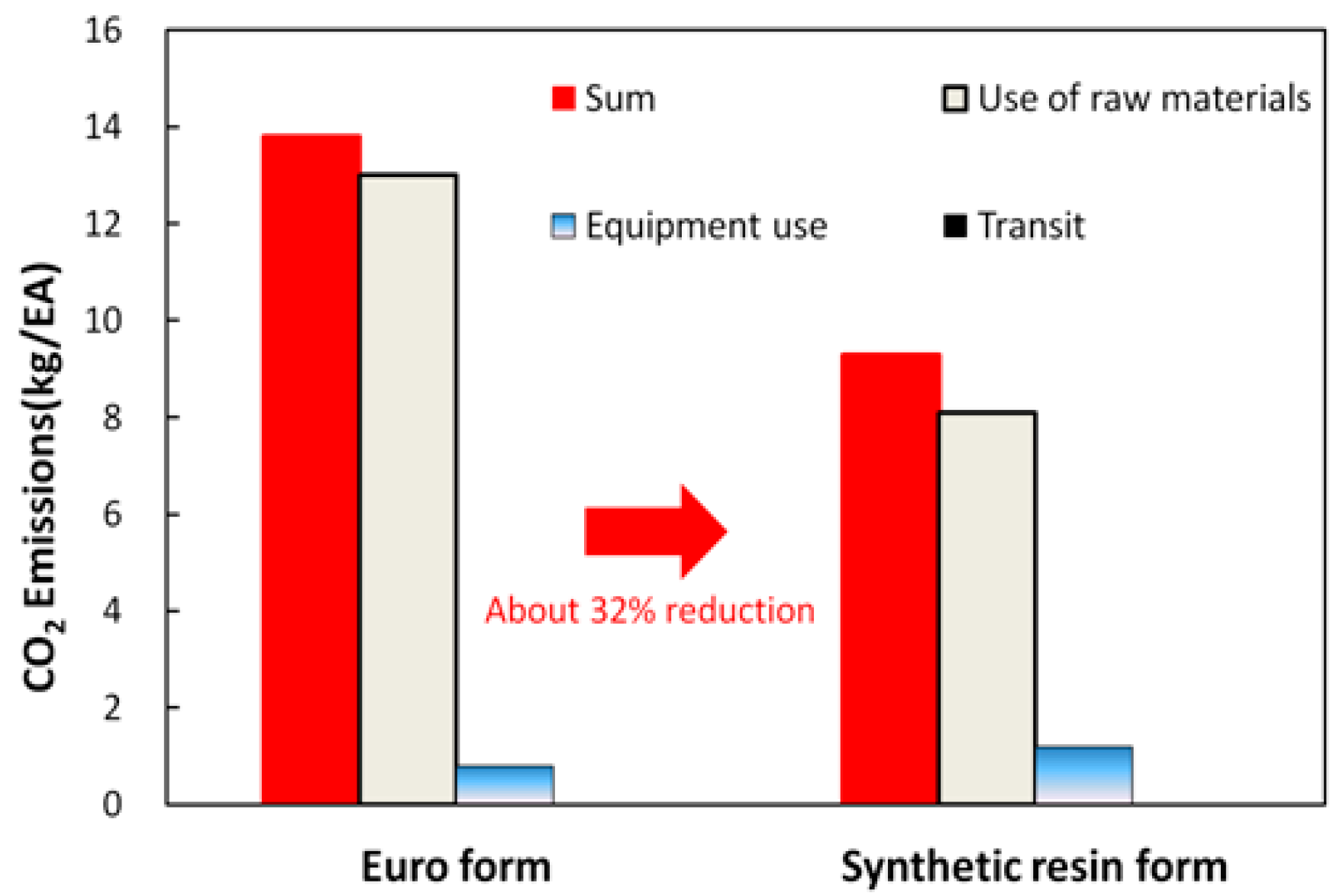
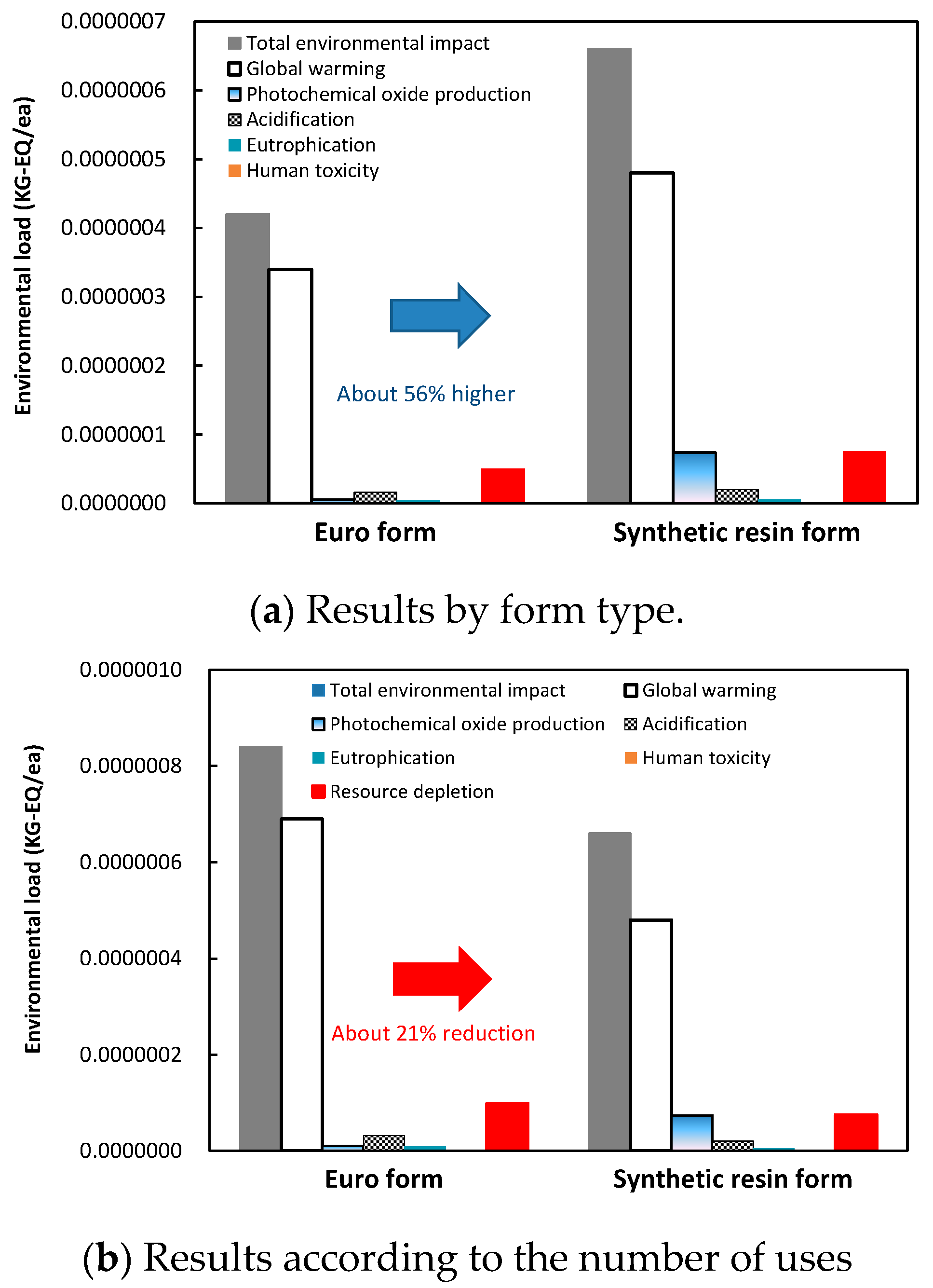
| Item | Test Specification | Unit | Test Value |
|---|---|---|---|
| Density | ASTM D792 | g/cm3 | 0.961 |
| MFR (190 °C, 2.16 kg) | ASTM D1238 | g/10 min | 5.5 |
| Softening point (vicat) | ASTM D1525 | °C | 125 |
| Tensile strength at yield point | ASTM D638 | kg/cm2 | 290 |
| Elongation at break | ASTM D638 | % | >500 |
| Shore hardness (Shore D) | ASTM D2240 | - | 65 |
| Flexural modulus 1% secant | ASTM D256 | kg·cm/cm | 8 |
| Specimen Composition | Environmental Condition |
|---|---|
| Material: Forms Size: 1200 mm × 600 mm (horizontal × vertical) Form Thickness: about 60 mm Form Hammer (metal) | Temperature: 9 ± 1 °C Humidity: 51 ± 3% R.H. Wind speed: 0 ± 1 m/s |
| Euro form | Maximum noise level [dB (A)] | No. 1 | 105.4 | average 107.3 |
| No. 2 | 107.2 | |||
| No. 3 | 106.6 | |||
| No. 4 | 108.4 | |||
| No. 5 | 108.7 | |||
| Background noise level [dB (A)] | 55.2 | |||
| Synthetic resin form | Maximum noise level [dB (A)] | No. 1 | 99.2 | average 99.7 |
| No. 2 | 100.4 | |||
| No. 3 | 98.2 | |||
| No. 4 | 102.1 | |||
| No. 5 | 98.4 | |||
| Background noise level [dB (A)] | 55.2 | |||
| Functional Unit | CO2 | CO | SOX | NOX | NH3 | Anthracite | Soft Coal | Natural Gas | Crude Oil | |
|---|---|---|---|---|---|---|---|---|---|---|
| Plywood | m3 | 8.01 × 102 | Information closed | 2.69 × 10−1 | 1.22 × 100 | Information closed | Information closed | Information closed | Information closed | Information closed |
| Press processing (3500 tons) | one time | 1.88 × 10−1 | 1.87 × 10−5 | 6.28 × 10−4 | 4.60 × 10−4 | 4.32 × 10−7 | 3.27 × 10−7 | 1.73 × 10−7 | 8.67 × 10−3 | 8.46 × 10−3 |
| Section steel | kg | 4.19 × 10−1 | 1.05 × 10−4 | 1.19 × 10−3 | 1.35 × 10−3 | 9.57 × 10−9 | 1.29 × 10−1 | 3.44 × 10−4 | 1.49 × 10−2 | 3.85 × 10−2 |
| HDPE | kg | 1.88 × 100 | 9.15 × 10−2 | 1.61 × 10−3 | 2.91 × 10−3 | 1.14 × 10−6 | 1.06 × 10−4 | 1.13 × 10−4 | 9.90 × 10−2 | 1.49 × 100 |
| PE injection molding | kg | 2.90 × 10−1 | 2.89 × 10−5 | 9.70 × 10−4 | 7.11 × 10−4 | 6.67 × 10−7 | 1.17 × 10−7 | 6.20 × 10−8 | 1.34 × 10−2 | 1.3 × 10−2 |
| Truck over 12 tons | kg/kg-km | 1.14 × 10−6 | 1.41 × 10−8 | - | 1.19 × 10−8 | 1.86 × 10−14 | 3.12 × 10−9 | - | 1.63 × 10−8 | 3.72 × 10−7 |
| Impact Category | Inventory | Characterization Coefficient | Normalization Reference |
|---|---|---|---|
| Resource depletion | Anthracite coal | 4.61 × 10−3/yr | 2.49 × 104 g/pr-yr |
| Bituminous coal | 4.61 × 10−3/yr | ||
| Natural gas | 1.671 × 10−2/yr | ||
| Crude oil | 2.48 × 10−2/yr | ||
| Global warming | CO2 | 1.00 × 100 g CO2-eq/g | 5.53 × 10−6 g CO2-eq/pr-yr |
| Photochemical oxide production | CO | 2.70 × 102 g C2H4-eq/g | 1.03 × 104 g C2H4-eq/pr-yr |
| SOx | 2.80 × 10−2 g C2H4-eq/g | ||
| NOx | 4.80 × 10−2 g C2H4-eq/g | ||
| Acidification | SOx | 1.00 × 100 g SO2-eq/g | 3.98 × 104 g SO2-eq/pr-yr |
| NOx | 7.00 × 10−1 g SO2-eq/g | ||
| NH3 | 1.88 × 100 g SO2-eq/g | ||
| Eutrophication | NOx | 1.30 × 10−1 g PO4−3-eq/g | 1.31 × 104 g PO4−3-eq/pr-yr |
| NH3 | 3.50 × 10−1 g PO4−3-eq/g | ||
| Human toxicity | SOx | 9.60 × 10−2 g 1.4 DCB-eq/g | 1.48 × 106 g 1.4 DCB-eq/pr-yr |
| NOx | 1.20 × 100 g 1.4 DCB-eq/g |
| Impact Category | Reduction Factor (Ni/Ti) | Relative Significance Factor (fi) | Weight (Wi) |
|---|---|---|---|
| Resource depletion | 1.06 | 0.218 | 0.231 |
| Global warming | 1.05 | 0.274 | 0.288 |
| Photochemical oxide production | 1.09 | 0.060 | 0.065 |
| Acidification | 1.05 | 0.034 | 0.036 |
| Eutrophication | 1.46 | 0.026 | 0.038 |
| Human toxicity | 1.42 | 0.074 | 0.105 |
| Division | Formworks | Inventory for Environmental Load (kg-eq/30 Uses) | ||||||
|---|---|---|---|---|---|---|---|---|
| Total Environmental Impact | Global Warming | Photochemical Oxide Production | Acidification | Eutrophication | Human Toxicity | Resource Depletion | ||
| CO2 emissions during formwork | Euro form | 4.2 × 10−7 | 3.4 × 10−7 | 5.4 × 10−9 | 1.6 × 10−8 | 4.7 × 10−9 | 1.1 × 10−9 | 5.0 × 10−8 |
| synthetic resin form | 6.6 × 10−7 | 4.8 × 10−7 | 7.4 × 10−8 | 2.0 × 10−8 | 5.9 × 10−9 | 1.4 × 10−9 | 7.5 × 10−8 | |
| CO2 emissions during formwork (30 uses) | Euro form | 8.4 × 10−7 | 6.9 × 10−7 | 1.1 × 10−8 | 3.2 × 10−8 | 9.5 × 10−9 | 2.3 × 10−9 | 9.9 × 10−8 |
| synthetic resin form | 6.6 × 10−7 | 4.8 × 10−7 | 7.4 × 10−8 | 2.0 × 10−8 | 5.9 × 10−9 | 1.4 × 10−9 | 7.5 × 10−8 | |
Disclaimer/Publisher’s Note: The statements, opinions and data contained in all publications are solely those of the individual author(s) and contributor(s) and not of MDPI and/or the editor(s). MDPI and/or the editor(s) disclaim responsibility for any injury to people or property resulting from any ideas, methods, instructions or products referred to in the content. |
© 2023 by the authors. Licensee MDPI, Basel, Switzerland. This article is an open access article distributed under the terms and conditions of the Creative Commons Attribution (CC BY) license (https://creativecommons.org/licenses/by/4.0/).
Share and Cite
Nam, K.-Y.; Lim, M.-K. Life Cycle Environmental Impact Assessment and Applicability of Synthetic Resin Formwork. Materials 2023, 16, 696. https://doi.org/10.3390/ma16020696
Nam K-Y, Lim M-K. Life Cycle Environmental Impact Assessment and Applicability of Synthetic Resin Formwork. Materials. 2023; 16(2):696. https://doi.org/10.3390/ma16020696
Chicago/Turabian StyleNam, Kyung-Yong, and Myung-Kwan Lim. 2023. "Life Cycle Environmental Impact Assessment and Applicability of Synthetic Resin Formwork" Materials 16, no. 2: 696. https://doi.org/10.3390/ma16020696





